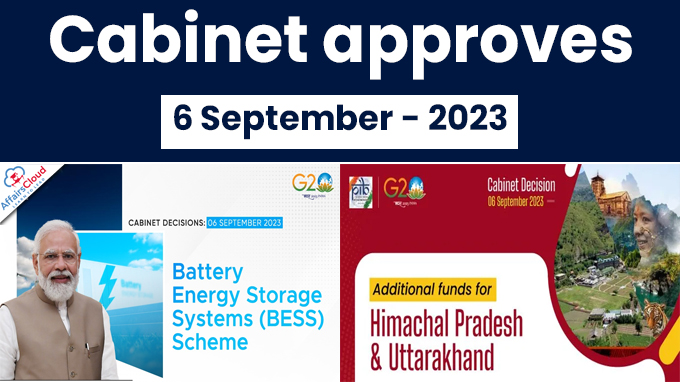 The Union Cabinet chaired by Prime Minister (PM) Narendra Modi has approved the following proposals on 6th September, 2023:
The Union Cabinet chaired by Prime Minister (PM) Narendra Modi has approved the following proposals on 6th September, 2023:
i.Approves ₹3,760 crore VGF for development of BESS.
ii.Approves additional allocation of Rs. 1164.53 crore for IDS, 2017 in Himachal Pradesh and Uttarakhand
Cabinet Approves ₹3,760 Crore VGF for Development of BESS
The Union Cabinet has approved a scheme for Viability Gap Funding (VGF) aimed at developing Battery Energy Storage Systems (BESS). The scheme is part of the government’s efforts to enhance renewable energy integration and reduce peak power demand costs. It was first introduced in the Union Budget 2023.
Objective: The objective is to provide clean, reliable, and affordable electricity to citizens while supporting the renewable energy sector, especially solar and wind power.
Scheme Overview:
i.Total project outlay: ₹9,400 crore.
- Government contribution: 40% of the total project cost, amounting to ₹3,760 crore, provided as VGF. Remaining 60% of project costs to be invested by participating companies.
- Budgetary grant included in the initial outlay: ₹3,700 crore.
ii. Beneficiaries:
- Developers selected through a competitive bidding process open to both public and private sectors.
- Focus on supporting power distribution companies (Discoms) by allocating a minimum of 85% of BESS project capacity to Discoms.
iii.It will be administered by the Department of Economic Affairs, Ministry of Finance.
iv.VGF to be disbursed in five tranches, linked to BESS project implementation stages.
v.Target Levelized Cost of Storage (LCoS) between ₹5.50-6.60 per kilowatt-hour (kWh) to make stored renewable energy economically viable.
Impact and Goals:
i.Reduce the cost of battery storage systems to increase their viability.
ii.Aims to develop 4,000 megawatt hours (MWh) of BESS by 2030-31.
iii.Facilitate the integration of renewable energy sources, such as solar and wind power, into the electricity grid.
iv.Intends to minimize wastage, optimize transmission network utilization, and reduce costly infrastructure upgrades.
Note: A DISCOM (Distribution Company) is a utility responsible for delivering electricity to end-users in a specific area. They operate and maintain the distribution infrastructure, manage billing, and ensure reliable electricity supply.
Background of Viability Gap Funding (VGF) Scheme:
- Launched in 2004.
- Aimed at supporting infrastructure projects under the Public-Private Partnership (PPP) model.
- Provides government grants to projects that are economically justified but not commercially viable due to large capital investments, long gestation periods, and the inability to increase user charges to commercial levels.
What is BESS:
- Battery Energy Storage System (BESS) stores energy from diverse sources, often with renewables, for cost-effective use during peak demand. BESS, comprising a battery system, inverter, battery management system, and energy management system, stores excess energy and releases it when needed, enhancing grid stability. Types include lead-acid, lithium-ion, LiFePO₄, and flow batteries.
About Ministry of Finance:
Union Minister – Smt. Nirmala Sitharaman (Rajya Sabha Constituency – Karnataka)
Minister of State (MoS) – Shri Pankaj Chaudhary and Dr. Bhagwat Kishanrao Karad
Cabinet Approves Additional Allocation of Rs. 1164.53 Crore for IDS, 2017 in Himachal Pradesh and Uttarakhand
The Cabinet approved an additional amount of Rs. 1164.53 crore for the Industrial Development Scheme (IDS), 2017, for Himachal Pradesh and Uttarakhand. The Ministry of Commerce and Industry, Department for Promotion of Industry and Internal Trade, proposed the allocation of additional funds under the Central Sector Scheme for Industrial Development Scheme 2017 for Himachal Pradesh and Uttarakhand.
Key Points:
i.The Industrial Development Scheme, 2017, was initially announced in 2018 for Himachal Pradesh and Uttarakhand.
ii.Rs. 1164.53 crore needed to fulfill scheme Commitments until 2028-2029.
iii. Approved additional funds will offer below incentives to eligible new and expanding industrial units in the manufacturing and service sectors under the scheme:
- Central Capital Investment Incentive for Access to Credit (CCIIAC):
Industrial units will receive a CCIIAC at a rate of 30% of the investment in Plant and Machinery, with an upper limit of Rs. 5.00 crore.
- Central Comprehensive Insurance Incentive (CCII):
Industrial units will be eligible for reimbursement of 100% of the insurance premium on building and Plant & Machinery for a maximum period of 5 years from the date of commencement of commercial production/operation.
Industrial Development Scheme for Himachal Pradesh (HP) & Uttarakhand, 2017
Objective: Accelerate industrialization and promote industrial growth in Himachal Pradesh and Uttarakhand.
Implementation: The scheme is implemented by the Ministry of Commerce and Industry, Department for Promotion of Industry and Internal Trade
Financial Outlay
- Initially: Rs. 131.90 crore, fully utilized by the fiscal year 2021-22.
- Additional approved funding: Rs. 1164.53 crore (on Sep 6, 2023)
Commencement and Duration:
- Effective from April 1, 2017, to March 31, 2022, has now been extended to cover the period up to 2028-29.
Eligibility:
i.All new and expanding industrial units in Himachal Pradesh and Uttarakhand’s manufacturing and services sectors, including Bio-technology and Hydel Power Generation Units up to 10 MW, qualify for incentives under the scheme.
Nodal Agency:
i.Himachal Prades – The Himachal Pradesh State Industrial Development Corporation Ltd. (HPSIDC)
ii.Uttarakhand – The State Industrial Development Corporation of Uttarakhand (SIDCUL)
About Department for Promotion of Industry and Internal Trade (DPIIT)
DPIIT was formed in January 2019 through the merger of the Department of Industrial Policy and Promotion (DIPP) and the Department of Commerce.
Ministry: Ministry of Commerce and Industry, Government of India.
Headquarters – New Delhi, Delhi
Secretary – Rajesh Kumar Singh
Centre Approves 10% Medical Education Reservation for Puducherry Government School Students
The Union Ministry of Home Affairs (MHA) has approved a proposal from Puducherry to implement a10% quota for students studying in government schools in medical admissions in Puducherry. The Centralised Admission Committee (CENTAC) is responsible for finalizing the list of students for admission to various higher education courses.
Implementation of the 10% Quota:
i.Eligibility: For NEET-qualified students who have studied from Class I-XII in government-run schools in Puducherry.
ii.The reservation is applicable to Bachelor of Medicine, Bachelor of Surgery (MBBS)/ Bachelor of Dental Surgery (BDS)/ Bachelor of Ayurveda Medicine and Surgery (BAMS) courses under government quota seats in government/private self-financing medical colleges in the Union Territory, starting from the academic year 2023-24.
Impact of the Quota:
- The quota is expected to benefit approximately 37 NEET-qualified government school students, providing them with medical admissions each year.
- This initiative aims to create more opportunities for deserving students and promote access to medical education.
About Puducherry
Chief Minister – N. Rangaswamy
Governor – Tamilisai Soundararajan
Festivals – Thai Pongal, Mascarade Festival (Mask Festival), Masi Magam, Bastille Day




